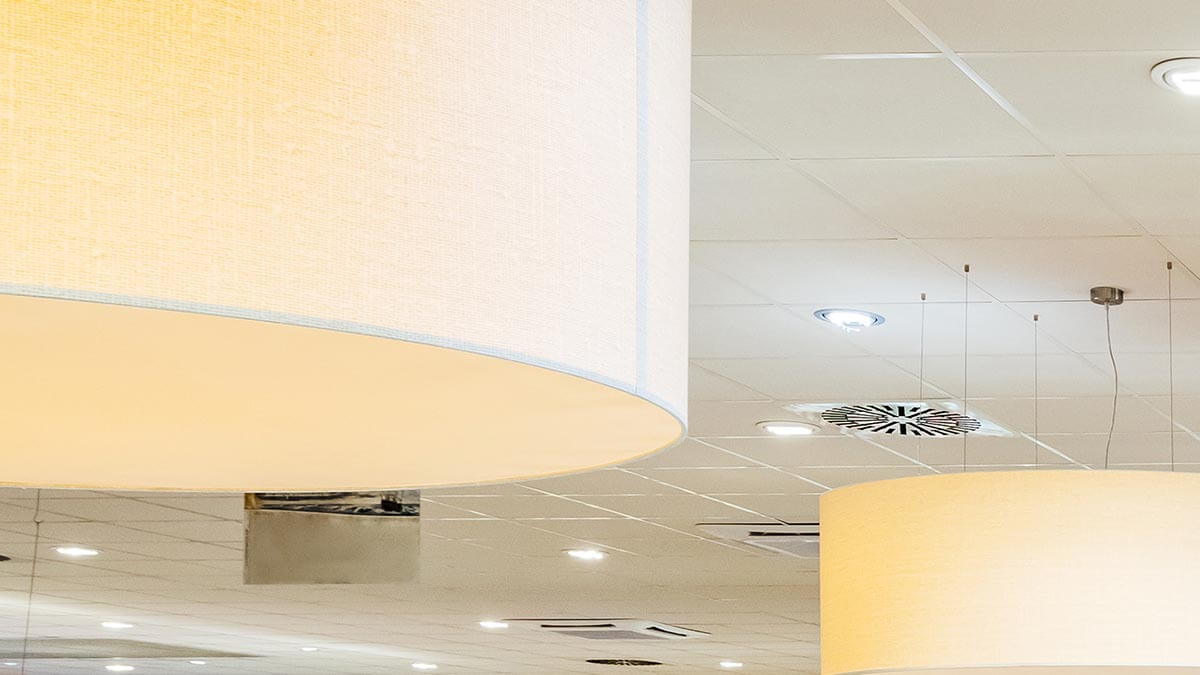Table of content
- The Psychology of Supermarket Lighting
- Strategic Supermarket Lighting for Different Departments
- Choosing the Right Ceiling Lights for Your Supermarket
- Industrial lighting: The Energy Efficiency Imperative
- Implementing a Supermarket Lighting Strategy
- Pro Tip: Data-Driven Lighting Adjustments
- The Future of Supermarket Lighting
- Conclusion
1. The Psychology of Supermarket Lighting
Light has a big effect on how people feel and behave, especially in places like supermarkets. The right supermarket lighting can make a store feel warm and welcoming, encouraging customers to stay longer. On the other hand, lighting that is too harsh or too dim can make the space feel uninviting, which might cause shoppers to leave sooner.
Different types of lighting create different moods. Warmer lighting (lower Kelvin values) gives a cozy, relaxed feel, which is why it’s often used in areas like bakery or deli sections where stores want customers to linger. Cooler lighting (higher Kelvin values) feels brighter and more energetic, making it great for areas where clear visibility is important, such as fresh produce or packaged goods.
Supermarkets can also use lighting to highlight key areas or products. Brighter or focused lighting can draw attention to special displays and boost sales. For example, using spotlights on new products or accent lighting on premium items makes them stand out more. Thoughtful supermarket lighting design acts like an invisible guide, leading customers through the store and influencing what they buy.
2. Strategic Supermarket Lighting for Different Departments
There’s no one-size-fits-all solution for supermarket lighting. Each section of a store has different lighting needs based on the products it sells and the kind of experience it wants to create for customers.
- Produce Section: Bright, crisp lighting makes fruits and vegetables look fresh and appetizing. Supermarkets often use lighting with a high Color Rendering Index (CRI) to ensure colors appear natural—reds look red, greens look green, and everything looks vibrant.
- Meat and Seafood Section: Like produce, accurate color is key, but slightly cooler lighting can make meats and seafood look even fresher. Some supermarkets use lighting designed to enhance red tones, making meats appear more appealing.
- Bakery Section: Warmer lighting adds a cozy feel and enhances the golden tones of baked goods. It can also create a more inviting atmosphere, making customers more likely to stop and browse.
- Dairy and Frozen Foods: Bright, even lighting ensures everything inside refrigerated cases is easy to see. Energy-efficient lighting is commonly used here since it gives off little heat, helping to keep products cold.
- General Aisles: Consistent, well-distributed lighting makes it easy for customers to find what they need. The goal is to eliminate shadows and ensure all shelves are clearly visible.
- Checkout Area: Bright lighting helps cashiers work efficiently and makes it easier for customers to complete their purchases comfortably.

3. Choosing the Right Ceiling Lights for Your Supermarket
Ceiling lights play a key role in any supermarket lighting system. The type of ceiling light used affects both the store’s atmosphere and functionality, making it important to choose the right option for each area.
- Flush Ceiling Lights: These lights are mounted directly to the ceiling, creating a clean and simple look. They work well in spaces with lower ceilings or where a minimalist design is preferred. Because they provide even lighting, they are a great choice for general aisle illumination, ensuring all products are clearly visible.
- Pendant Light: Hanging from the ceiling, pendant lights add a stylish and decorative touch to a space. They are often used in areas that benefit from a more focused or inviting lighting effect, such as over bakery counters or deli sections, where a warm and welcoming feel can enhance the shopping experience.
- LED Ceiling Lights: These have become a top choice for supermarkets due to their energy efficiency, long lifespan, and flexibility. Available in various styles, including flush mount, pendant, and panel lights, LED ceiling lights provide bright, consistent illumination while reducing energy costs. Their durability and lower maintenance needs make them an economical choice for large retail spaces.
- Neon Lights: While neon lights were once common in retail settings, they are now rarely used in supermarkets. Newer technologies, such as LED ceiling lights, offer better efficiency, longer life, and lower maintenance, making them a more practical choice for modern supermarket lighting.
When selecting ceiling lights, factors like ceiling height, aisle width, and overall store design should be considered.
A lighting professional can help determine the best type, placement, and brightness for each section of the supermarket. They can also recommend lighting controls, such as dimmers and timers, which can improve energy efficiency and create different lighting effects throughout the day.
Are you looking for a professional in supermarket lighting to help you create the perfect atmosphere for your store? Then request a quote today on europages to find the perfect supplier for your projet: https://www.europages.fr/en/rfq

4. Industrial Lighting: The Energy Efficiency Imperative
Industrial Lighting is a big part of a supermarket’s operating costs, especially in large spaces. Traditional lighting, like fluorescent and incandescent bulbs, uses a lot of energy and doesn’t last very long. This leads to higher electricity bills and frequent replacements, adding to maintenance costs.
Switching to energy-efficient supermarket lighting, especially LED technology, can save a lot of money. LEDs use much less energy—often cutting lighting costs by 50% or more. They also last much longer, up to 50,000 hours or more, compared to just 1,000–2,000 hours for incandescent bulbs and 10,000–20,000 hours for fluorescent tubes. This means fewer replacements, lower maintenance costs, and fewer disruptions to store operations.
Energy-efficient lighting isn’t just good for cutting costs—it’s also better for the environment. Using less energy reduces a store’s carbon footprint, making it a more sustainable choice. Plus, many customers appreciate businesses that take steps to be more eco-friendly.
For more details on lighting and energy efficiency standards, check out this resource by the European Commission: Energy - European Commission
5. Implementing a Supermarket Lighting Strategy
Updating supermarket lighting takes planning.
Here’s a simple step-by-step guide:
- Check Your Current Lighting – Look at your existing supermarket lighting. Identify what kind of fixtures you have, such as neon lights, ceiling lights, pendant lights, or flush ceiling lights. See if any areas are too dark, too bright, or using outdated lighting.
- Set Your Goals – Decide what you want to improve. Are you looking to save energy, enhance product visibility, or create a better shopping experience? LED ceiling lights are a great option for energy efficiency.
- Plan the Layout – Work with a lighting expert to design the best setup. Think about ceiling height, aisle width, and product displays to determine the right mix of supermarket lighting.
- Pick the Right Fixtures – Choose high-quality, energy-efficient lights that fit your needs. Consider factors like brightness, color, and how long they last.
- Install the Lights – A professional electrician should handle the installation to ensure everything works safely and efficiently.
- Use Smart Controls – Features like dimmers, timers, or motion sensors can help save energy and adjust lighting as needed.
- Check and Adjust – After installation, monitor energy use and get feedback from staff and customers. Make changes if necessary.
- Maintain Your Lighting – Regularly check and replace fixtures to keep everything running well.
6. Pro Tip: Data-Driven Lighting Adjustments
To get the most out of supermarket lighting, use a data-driven approach. Track sales numbers for different products and sections before and after making lighting changes. Look at customer movement and how long they stay in different areas. Use this information to adjust lighting as needed.
For example, if a product display isn’t selling well, try using brighter or more focused lighting to see if it helps. If customers aren’t spending much time in a certain section, change the lighting to make it feel more inviting. A professional can help gather data on customer engagement to guide these decisions.
Are you a professional specialized in lighting solutions and do you want to offer your services? Then request a consultation with our team: https://supplier.europages.com/en/rfc

7. The Future of Supermarket Lighting
The future of supermarket lighting is likely to be driven by advancements in LED technology, smart controls, and data analytics. We can expect to see:
- Even More Energy Efficiency: LED technology continues to improve, with further reductions in energy consumption and longer lifespans.
- Dynamic Lighting: Systems that can automatically adjust lighting levels and color temperature based on time of day, customer traffic, or even weather conditions.
- Personalized Lighting: The ability to tailor lighting to individual customer preferences, potentially through mobile apps or loyalty programs.
- Integration with Other Systems: Lighting systems that are integrated with other building management systems, such as HVAC and security, for greater efficiency and control.
- Li-Fi Technology: Li-Fi (Light Fidelity) is an emerging wireless communication technology that uses light to transmit data. In a supermarket setting, Li-Fi could be used to provide location-based services to customers, such as personalized offers or product information, delivered through their smartphones via the store's lighting system.
For more information on supermarkets and the food industry, read these insightful articles:
- Glass Food Storage Containers for supermarkets
- Edible Food Packaging: A Sustainable Future?
- Fermented Foods: Benefits, Trends & Sustainability
- Stainless Steel in Food Processing: Highest Hygiene
- Gluten-Free Sweets: A Growing Market for B2B Bakeries
- Advancing Market Potential with Plant-Based Food Innovations
- Foodceuticals: The Future of Food & Health
- Vegan Sweets: A Growing Market for Bakeries
8. Conclusion
Modern supermarket lighting does more than just brighten the space—it shapes the shopping experience. Thoughtful choices, like warm pendant lights in the bakery or even flush ceiling lights in the aisles, guide customers and influence purchases.
Upgrading to energy-efficient LED ceiling lights instead of outdated neon lights not only improves the look of the store but also saves money with quick payback periods and long-term cost reductions. A smart industrial lighting plan tailored to a supermarket’s needs is now essential for both profitability and sustainability.
Another interesting aspect of supermarket lighting is its impact on food quality. Beyond influencing sales and energy use, the type of light used can affect how long fresh products stay in top condition.
Certain wavelengths, like UV and infrared, can speed up spoilage, cause discoloration, and reduce nutrients in food. UV light can damage cells, while infrared generates heat that puts extra strain on refrigeration systems.
Choosing lighting that minimizes these effects helps supermarkets to extend shelf life, reduce waste, and keep products fresher. This highlights how lighting isn't just about visibility—it also plays a key role in food preservation and overall store efficiency.
Find Lighting Suppliers for Your Next Project!
SIPRIX: The company specializes in professional electrical installations for commercial spaces, providing energy-efficient lighting solutions and reliable power distribution, including LED panel installation and comprehensive distribution board setup. Their services ensure optimal lighting performance, safety, and compliance, maximizing both operational efficiency and cost savings for businesses like supermarkets.
Radium Lampenwerk GmbH: Germany's oldest active lamp manufacturer, offers high-quality lighting solutions, blending traditional lamp expertise with innovative LED technology to meet the evolving needs of specialist retailers, international clients, and industrial applications. With over a century of experience, Radium provides both high-volume production and specialized custom lamps, ensuring excellent quality and customer service for diverse lighting requirements.
Struck – Leuchten GmbH & Co. KG: Is a leading German manufacturer of high-quality illuminated advertising systems, serving a diverse clientele across Europe, including major breweries, insurance companies, and renowned brands. They offer comprehensive in-house production, from design and manufacturing to installation and maintenance, providing clients with customized branding solutions and complete project management, ensuring a distinctive and impactful brand presence.
LB-electronics GmbH: Founded in 1981, is a market-leading distributor of high-quality broadcast technologies, offering a comprehensive range of products and specialized system solutions, including studio planning, lighting technology, and mobile transmission. The company's expertise extends to providing tailored services and support, solidifying its position within the LB Group as a key provider of innovative broadcast solutions.
Jung-Leuchten: A family-owned business for over 65 years, specializes in developing and manufacturing high-quality, durable technical lighting, including explosion-proof LED lights certified for hazardous environments (ATEX zones 1, 21, 2, and 22). They offer a wide range of customizable lighting solutions—in steel, stainless steel, or aluminum, with various finishes, mounting options, and protection classes—for diverse applications, from industrial workspaces and cleanrooms to specialized cabins and surface control.
HEMAPLAST: A family-owned company with over 40 years of experience, specializes in the development, production, and maintenance of skylights, roof light strips, and natural smoke and heat extraction systems (RWA/NRA). They are known for their high-quality, durable products, reliability, and service, providing both standard and customized solutions for new construction and roof renovation projects.
Lichttechnik Hessling: A leading electrical service specialist for nearly 50 years, provides comprehensive lighting solutions, including television-ready floodlight systems for stadiums and arenas, and architectural lighting for buildings. Offering a full range of services from planning and installation to maintenance, Hessling, along with its subsidiaries specializing in lightning protection and network construction, delivers complete project management from a single source.
Delychi GmbH: Offers resource-efficient manufacturing, production monitoring, and freight logistics services, specializing in high-quality LED lighting solutions for various applications. Their product range includes energy-saving linear lighting systems, versatile recessed lights, track systems, advertising modules, controllers, and LED tubes.
BLLS LEDLighting: This company offers exceptionally competitive pricing on a wide range of lamps and lighting systems, including LED bulbs, tubes, strip lights, spotlights, panels, and floodlights. Their direct-from-Asia manufacturing, without intermediaries, allows for significantly lower prices than competitors.
Eco Green Plus: An Italian company founded in 2022, offers comprehensive energy efficiency and sustainability solutions for businesses and individuals. Their services include energy supply, photovoltaic system design and installation, LED relamping, electric vehicle charging, HVAC systems, industrial solutions, and sustainability reporting, promoting cost reduction and a transition to clean energy.
M-Tech: This electrical installation company, with a team of over 100 experienced professionals, specializes in high-quality, precise electrical work for residential, commercial, and industrial projects. Their services include smart home installations, information systems, complex electrical connections, and lighting system installation and repair, with a commitment to modern methods and ongoing training to meet evolving industry demands.
Capital City Electrical: NICEIC-approved electrical contractors, offers a wide range of electrical services, including lighting design and installation, for both residential and commercial clients in Edinburgh, Scotland, and Northern England. They also provide wiring, emergency services, electrical testing, and OLEV-accredited EV charger installations.

